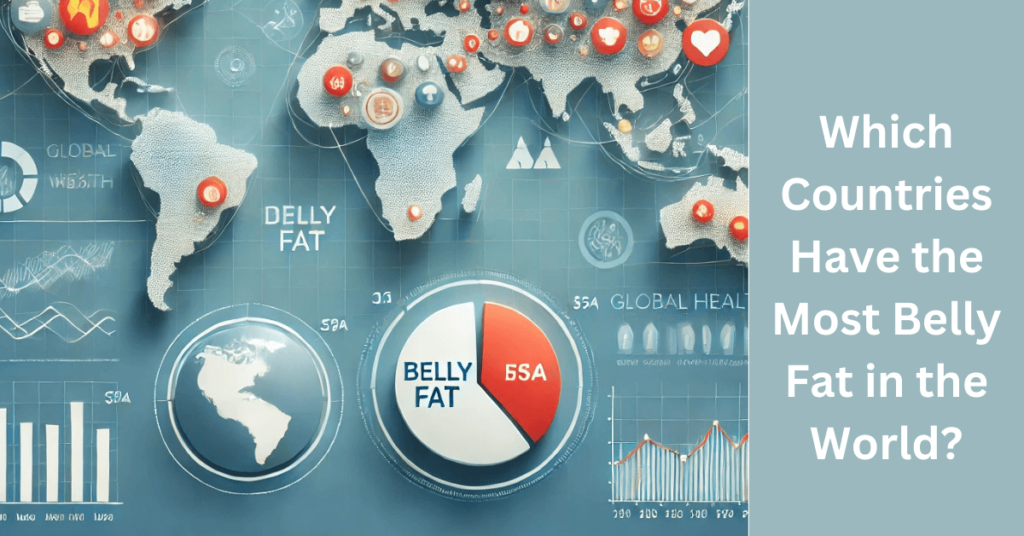Which Countries Have the Most Belly Fat in the World? A Deep Dive into Global Health Trends Belly fat, or visceral fat, is a growing concern worldwide. While obesity rates vary across nations, certain countries stand out for having higher levels of belly fat in their populations. This article explores the global distribution of belly fat, the reasons behind it, and its health implications. So, which country has the most belly fat in the world? Let’s uncover the facts.

What Is Belly Fat and Why Does It Matter?
Before identifying which countries top the list, it’s crucial to understand belly fat and why it matters. Belly fat is the fat stored around the abdominal organs. Unlike subcutaneous fat, which is stored just under the skin, visceral fat is metabolically active and contributes to several health risks.
Health Risks of Belly Fat:
- Increased risk of heart disease and stroke.
- Higher likelihood of type 2 diabetes.
- Greater chances of developing certain cancers.
- Contribution to hormonal imbalances and inflammation.
The Country with the Most Belly Fat: Key Contenders
Global studies on obesity and belly fat suggest that countries with higher obesity rates often have higher levels of visceral fat in their populations. Based on health statistics, some of the leading contenders include:
1. United States
The United States consistently ranks as one of the most obese countries in the world. According to the Centers for Disease Control and Prevention (CDC), over 40% of American adults are classified as obese. This high obesity rate correlates strongly with increased belly fat levels.
- Contributing Factors:
- High consumption of processed and fast foods.
- Sedentary lifestyles and reduced physical activity.
- Socioeconomic disparities affecting access to healthy foods.
2. Mexico
Mexico has seen a sharp rise in obesity and belly fat levels in recent years. The country’s love for sugary beverages and calorie-dense traditional foods has made it a hotspot for belly fat accumulation.
- Contributing Factors:
- High soda consumption—Mexico is one of the largest consumers of sugary drinks globally.
- Urbanization leading to reduced physical activity.
- Limited awareness of healthy dietary practices.
3. Middle Eastern Countries
Countries like Kuwait, Qatar, and Saudi Arabia also report high levels of obesity and belly fat. Cultural practices, coupled with extreme climates, often lead to reduced physical activity in these regions.
- Contributing Factors:
- High consumption of calorie-dense foods.
- Preference for indoor lifestyles due to extreme heat.
- Limited emphasis on physical fitness.
4. Pacific Island Nations
Nations like Nauru, Tonga, and Samoa have some of the highest obesity rates in the world. Belly fat prevalence is particularly high due to genetic predispositions and the adoption of Western diets rich in processed foods.
- Contributing Factors:
- Transition from traditional diets to imported, processed foods.
- Genetic factors that predispose populations to weight gain.
- Lack of access to healthcare and fitness resources.
Why Do Some Countries Have More Belly Fat?
Understanding why certain countries have higher levels of belly fat involves analyzing cultural, economic, and environmental factors. Here are some common contributors:
1. Dietary Habits
Countries with high consumption of processed foods, sugary drinks, and fast foods tend to have higher obesity and belly fat rates. Poor dietary choices are often influenced by economic factors and food marketing.
2. Physical Activity Levels
Sedentary lifestyles are a significant contributor to belly fat. Urbanization, desk jobs, and a lack of emphasis on physical education have reduced activity levels in many populations.
3. Economic Factors
Low-income communities often lack access to healthy foods and fitness facilities, leading to higher obesity rates. Conversely, high-income societies may indulge in excess calorie consumption and sedentary entertainment options.
4. Cultural Norms
Cultural attitudes toward food, body image, and physical activity can influence belly fat levels. In some cultures, larger body sizes are associated with wealth and health, which may discourage weight loss efforts.
The Impact of Belly Fat on Global Health
Belly fat is more than just a cosmetic issue. Its health implications are profound and far-reaching. Here’s how high levels of belly fat affect global health:
1. Increased Healthcare Costs
Countries with high belly fat prevalence face soaring healthcare costs due to the treatment of obesity-related diseases like diabetes, heart disease, and cancer.
2. Reduced Workforce Productivity
Chronic diseases associated with belly fat lead to absenteeism and reduced productivity in the workforce.
3. Shortened Life Expectancy
Visceral fat’s contribution to severe health conditions often results in lower life expectancies in affected populations.
Can Countries Combat the Belly Fat Epidemic?
Addressing belly fat on a national level requires a multifaceted approach. Governments, healthcare systems, and communities must work together to implement effective solutions.
1. Promoting Healthy Diets
Encouraging the consumption of whole foods, fruits, vegetables, and lean proteins can help reduce belly fat levels. Public health campaigns can raise awareness about the dangers of processed foods.
2. Encouraging Physical Activity
Governments can invest in public fitness facilities, parks, and active transportation infrastructure to encourage regular exercise.
3. Implementing Policy Changes
Taxes on sugary drinks, subsidies for healthy foods, and regulations on food marketing can positively influence dietary habits.
4. Education and Awareness
Educating the public about the risks of belly fat and the benefits of healthy lifestyles can empower individuals to make better choices.
Final Thoughts: Which Country Tops the List?
While it’s challenging to pinpoint a single country with the most belly fat, nations like the United States, Mexico, and Pacific Island countries consistently rank high due to their obesity rates and contributing factors. However, the belly fat epidemic is a global issue that transcends borders, affecting both developed and developing nations.
The good news is that belly fat is reversible with the right lifestyle changes. By adopting healthier diets, increasing physical activity, and addressing systemic challenges, countries can combat this growing health crisis and improve the well-being of their populations.

